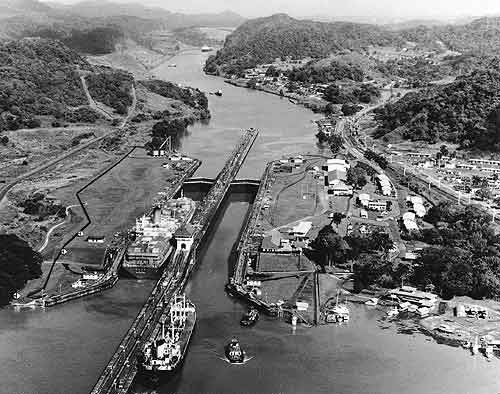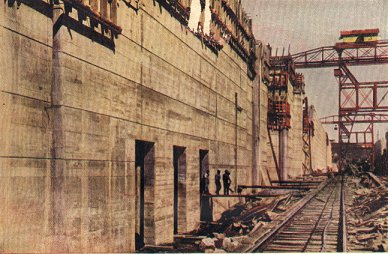 |
usa | world | animals | vocabulary | health | science | math | history |
Panama Canal
The Panama Canal is a large canal, 82 kilometres (51 miles) long, that cuts through the isthmus of Panama, connecting the Atlantic and Pacific Oceans. Because of the S shape of Panama, the Atlantic lies to the west of the canal and the Pacific to the east, reversing the normal orientation. It opened on August 15, 1914.
The canal has two sets of canal locks on the Pacific side and one on the Atlantic. At the Atlantic end, the massive steel gates of the triple locks at Gatún are 70 feet (21 m) high and weigh 745 tons each, but are so well-counterbalanced that a 30 kW (40 horsepower) engine suffices to open and close them. Lake Gatún, which is 26 metres above sea level, is fed by the Chagres River, which was dammed to make the lake. From Lake Gatún, the canal passes through the continental divide at the Gaillard Cut, and then descends to the Pacific first through a single set of locks at Pedro Miguel to Miraflores Lake at 16.5 metres above sea level, and then through a double set of locks at Miraflores. All the locks on the canal are paired so that ships may pass in both directions. The ships are hauled through the locks with small railway engines. The Pacific end of the canal is 24 cm higher than the Atlantic end and has much greater tides.

Several islands are located within the Lake Gatún portion of the Panama Canal, including Barro Colorado Island, a world-famous wildlife sanctuary.
The dream of a canal across the isthmus of Central America goes back centuries, and there was serious discussion of its possible construction from the 1820s onwards. The two most favorable routes were those across Panama and across Nicaragua, with a route across the Isthmus of Tehuantepec in Mexico as a third option. The Nicaragua route was seriously considered and surveyed; see Nicaragua Canal.
The Panama Railway was built across the isthmus from 1850 to 1855. The infrastructure of this functioning railroad was a key consideration in the plan to build the canal in Panama.
Prior to the Panama Canal's construction, the fastest way to travel by ship from New York to California would have been by "rounding the Horn", the long and dangerous route via Cape Horn (at the southernmost tip of South America).

After the success of the Suez Canal in Egypt, the French were confident that they could connect another two seas with little difficulty. In May of 1879, the International Canal Congress was held in Paris. Delegates from 22 nations considered the Nicaraguan route, the Isthmus of Tehuantepec, but the majority settled on Panama.
Ferdinand de Lesseps, who was in charge of the construction of the Suez Canal, was initially called upon to build the new canal at Panama and construction began on January 1, 1880.
The dream of a canal across the isthmus of Central America goes back centuries, and there was serious discussion of its possible construction from the 1820s onwards. The two most favorable routes were those across Panama and across Nicaragua, with a route across the Isthmus of Tehuantepec in Mexico as a third option. The Nicaragua route was seriously considered and surveyed; see Nicaragua Canal.
The Panama Railway was built across the isthmus from 1850 to 1855. The infrastructure of this functioning railroad was a key consideration in the plan to build the canal in Panama.
Prior to the Panama Canal's construction, the fastest way to travel by ship from New York to California would have been by "rounding the Horn", the long and dangerous route via Cape Horn (at the southernmost tip of South America).
After the success of the Suez Canal in Egypt, the French were confident that they could connect another two seas with little difficulty. In May of 1879, the International Canal Congress was held in Paris. Delegates from 22 nations considered the Nicaraguan route, the Isthmus of Tehuantepec, but the majority settled on Panama.
Ferdinand de Lesseps, who was in charge of the construction of the Suez Canal, was initially called upon to build the new canal at Panama and construction began on January 1, 1880.
However, there was a vast difference between digging quantities of sand in a dry flat area and removing enormous quantities of rock from the middle of a jungle. Floods, mudslides, and high mortality rates from malaria, yellow fever and other tropical diseases eventually forced the French to abandon the project.
President Theodore Roosevelt of the United States was confident that the United States could complete the project, and recognized that US control of the passage from the Atlantic to Pacific oceans would be militarily and economically important. Panama was then part of Colombia so Roosevelt proceeded to negotiate with the Colombians to obtain the necessary permission. In early 1903 the Hay-Herran Treaty was signed by both nations, but the Colombian Senate failed to ratify the treaty. In a controversial move, Roosevelt implied to Panamanian rebels that if they revolted, the U.S. Navy would assist their cause for independence. Panama proceeded to proclaim its independence on November 3, 1903, and the USS Nashville in local waters impeded any interference from Colombia.
When fighting began Roosevelt ordered US battleships stationed off of Panama's coast for "training exercises". Many argue that fear of a war with the United States caused the Colombians to avoid any serious opposition to the revolution. The victorious Panamanians returned the favor to Roosevelt by allowing the United States control of the Panama Canal Zone on February 23, 1904 for US$10 million (as provided in the Hay-Bunau-Varilla Treaty, signed on November 18, 1903).
Control of the zone was exercised by the Isthmian Canal Commission during canal construction. The commission was staffed by military officers and initially chaired by Admiral John C. White. The first success of the North Americans was to eliminate the noxious yellow fever that had killed so many construction workers. Based on the work of Cuban doctor Juan Carlos Finlay, Walter Reed had determined in Cuba during the Spanish-American War that the disease was spread by mosquitos. 20,000 French workers had died from it. However, new health measures led by Dr William C. Gorgas eliminated yellow fever in 1905 and improved general sanitation and working conditions.
The first chief engineer of the project was John Findlay Wallace. Hampered by disease and poor organization, his work did not go well and he resigned after one year. The second chief engineer, John Stevens, set up much of the infrastructure necessary for construction of the canal, including building housing for construction workers, rebuilding the Panama Railway to accommodate heavy freight traffic, and devising an efficient system for removing spoil from the excavations by rail. He resigned in 1907. US Colonel George Washington Goethals was the last chief engineer and his management of the project was highly praised. The work was still grueling, but great progress was made.
De Lesseps had insisted on a sea-level canal, but the French engineers never found a solution for dealing with Chagres River, which crossed the line of the canal many times. The Chagres was prone to tremendous floods in the rainy season and a sea-level canal would have had to carry its entire drainage. The lock canal plan finally selected by Stevens and built by Goethals harnessed the Chagres by means of a huge earthfill dam at Gatún. The resulting artificial lake not only provided the water and hydroelectric power to operate the canal locks, but also a water "bridge" covering a third of the distance across the isthmus. Under Goethals's leadership, the engineering work on the canal was broken down into construction of the breakwaters, dams, and locks at either end; and the great task of excavation through the Continental Divide at Culebra, now known as the Gaillard Cut. Even with the change from a sea-level to lock canal, the final volume of excavation was almost four times that initially estimated by de Lesseps.
US President Woodrow Wilson triggered the blowing up of the Gamboa Dike on October 10, 1913 thus completing the construction of the canal. Numerous West Indian laborers had worked on the Canal, and official mortality figures were 5,609 lives.
When the canal opened on August 15, 1914 it was a technological marvel. A complex series of locks allowed even the largest ships to pass. The canal was an important strategic and economic asset to the US, and revolutionized world shipping patterns.
The United States used the canal during World War II to help revitalize their devastated Pacific Fleet. Some of the largest ships the United States had to send through the canal were aircraft carriers, in particular the Essex class. These were so large that, although the locks could hold them, the lampposts that lined the canal had to be removed. The largest ships able to go through the canal are described as being of Panamax size.
The canal and the Canal Zone surrounding it were administered by the United States until 1999 when control was relinquished to Panama. This was the result of the September 7, 1977 signing of the Torrijos - Carter Treaty in which US president Jimmy Carter conceded to Panamanian demands for control. The treaty called for a gradual handover that placed the canal completely under Panamanian jurisdiction by December 31, 1999. The treaty was highly controversial in the U.S., and its passage was by no means certain. It was revealed in 1997 by General Manuel Noriega that the Torrijos government had a plan in effect to sabotage the canal if the U.S. failed to ratify the treaty. Noriega also claims that the invasion of Panama under Operation Just Cause was primarily launched to circumvent the treaty.
Panama's Law No. 5 was passed on January 16, 1997 to confirm 25-to-50-year leases for the U.S.-built ports of Cristobal on the Atlantic end of the canal and Balboa on the Pacific end and "operation of the canal" to a Chinese Hong Kong corporation named Hutchison Whampoa operating under the name Hutchison Port Holdings and headed by Li Ka Shing, the wealthiest Chinese individual. Accusations that "Red China controls the Panama Canal" are based on this.
This article is licensed under the GNU Free Documentation License. It uses material from the Wikipedia article "Panama Canal".